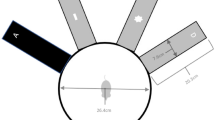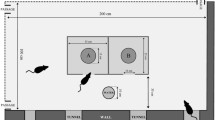Abstract
Synthetic stoat odor (3-propyl-1,2-dithiolane and 2-propylthietane) and fox fecal odor (2,5-dihydro-2,4,5-trimethylthiazoline) at various concentrations were applied to chick-peas (Cicer arietinum) at sowing in an investigation aimed at reducing damage caused by house mice (Mus musculus). Stoat odor at 10% concentration exerted a measure of protection, as did 1% fox odor against predation by laboratory mice. Wild mice were less affected by synthetic predator odor and appeared to have a shorter memory for it. Laboratory mice cannot be regarded as surrogate wild mice, when used in experimental situations such as those employed here.
Access this article
We’re sorry, something doesn't seem to be working properly.
Please try refreshing the page. If that doesn't work, please contact support so we can address the problem.
Similar content being viewed by others
References
Allan, G.G., Gustafson, D.I., Mikels, R.A., Miller, J.M., andNeogi, S. 1984. Reduction of deer browsing of Douglas fir (Pseudotsuga menziesii) seedlings by quadrivalent selenium.For. Ecol. Manage. 7:161–181.
Andelt, W.F., Burnham, K.P., andManning, J.A. 1991. Relative effectiveness of repellents for reducing mule deer damage.J. Wildl. Manage. 55:341–347.
Crump, D.R. 1982. Synthesis of (2S)-2-propylthietane.Aust. J. Chem. 35:1945–1948.
Day, R.W., andQuinn, G.P. 1989. Comparisons of treatments after an analysis of variance in ecology.Ecol. Monogr. 59:433–463.
Holmes, W.G. 1991. Predator risk affects foraging behavior of pikas: Observational and experimental evidence.Anim. Behav. 42:111–119.
Kavaliers, M. 1990. Responsiveness of deer mice to a predator, the short-tailed weasel: Population differences and neuromodulatory mechanisms.Physiol. Zool. 63:388–407.
Montague, T.L.,Pocock, D.C., andWright, W. 1990. An examination of the animal browsing problem in Australian eucalypt and pine plantations, pp. 203–208,in L.R. Davis and R.E. Marsh, (eds.). Proceedings of the 14th Vertebrate Pest Conference, University of California-Davis.
Sullivan, T.P., andCrump, D.R. 1984. Influence of mustelid scent-gland compounds on suppression of feeding by snowshoe hares (Lepus americanus).J. Chem. Ecol. 10:1809–1821.
Sullivan, T.P., Nordstrum, L.O., andSullivan, D.S. 1985a. Use of predator odors as repellents to reduce feeding damage by herbivores. I. Snowshoe hares (Lepus americanus).J. Chem. Ecol. 11:903–919.
Sullivan, T.P., Nordstrom, L.O., andSullivan, D.S. 1985b. Use of predator odors as repellents to reduce feeding damage by herbivores. II. Black-tailed deer (Odocoileus hemionus columbianus).J. Chem. Ecol. 11:921–935.
Sullivan, T.P., Crump, D.R., andSullivan, D.S. 1988a. Use of predator odors as repellents to reduce feeding damage by herbivores. III. Montane and meadow voles (Microtus montanus andMicrotus pennsylvanicus).J. Chem. Ecol. 14:363–377.
Sullivan, T.P., Crump, D.R., andSullivan, D.S. 1988b. Use of predator odors as repellents to reduce feeding damage by herbivores. IV. Northern pocket gophers (Thomomys talpoides).J. Chem. Ecol. 14:379–389.
Vernet-Maury, E., andConstant, B. 1991. Repellent effects of trimethyl thiazoline in the wild rat,Rattus norvegicus Berkenhout. Chemical Signals in Vertebrates VI,Abstract, 96.
Author information
Authors and Affiliations
Rights and permissions
About this article
Cite this article
Coulston, S., Stoddart, D.M. & Crump, D.R. Use of predator odors to protect chick-peas from predation by laboratory and wild mice. J Chem Ecol 19, 607–612 (1993). https://doi.org/10.1007/BF00984995
Received:
Accepted:
Issue Date:
DOI: https://doi.org/10.1007/BF00984995




